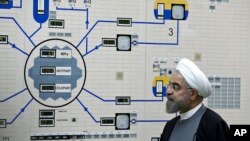Iran and six major powers are intensifying negotiations in the Swiss city of Lausanne ahead of an end-of-March deadline for a historic framework agreement that would curb Tehran's nuclear program in exchange for lifting sanctions.
Officials said a deal is unlikely this week, because of Nowruz, the Persian New Year, on March 21.
Iran denies allegations by Western powers and their allies that it is seeking a nuclear weapons capability.
Following are details about key issues under negotiation based on information from sources close to the negotiations. Most of the issues are agreed, but sticking points remain.
Break-out time
The goal of the negotiations is an arrangement whereby Iran would need at least one year to produce enough fissile material -- high enriched uranium or plutonium -- for a single atomic weapon, should Tehran choose to produce one. That is known as the “break-out” time.
Officials say the six powers, which have been negotiating with Iran since October 2013, do not share their individual methods of calculating break-out time for Tehran. But they have all reached the same conclusions.
Duration of deal
U.S. President Barack Obama said in an interview on March 2 with Reuters that Iran will need to accept limits on its nuclear program for at least 10 years. Recently Iran had wanted eight years and the United States 20 years. They have compromised at 10 years.
Uranium enrichment
Originally Iran wanted to maintain all of its uranium enrichment centrifuges, machines that purify uranium for use as fuel in power plants or, if very highly enriched, in weapons. That was around 10,000 operational out of nearly 20,000 total.
The United States and other Western powers originally wanted Iran to reduce that number to several hundred. Numbers are still being discussed. Iran wants to keep around 9,000 while Western powers have preferred less and might be open to around 6,500.
The issue has not been resolved.
Research and development
Officials close to the talks said that Iran's desire to pursue research and development into advanced centrifuges is one of the biggest sticking points in the talks. Iran insists that it should be allowed to continue R&D into advanced centrifuges, but Western powers are extremely uncomfortable with allowing Tehran to continue developing more efficient centrifuges that would shorten the break-out time.
Plutonium
Western powers had originally wanted Iran to dismantle a heavy-water reactor at Arak that could yield significant quantities of plutonium. Tehran refused to do so but has agreed to the idea of converting or operating it in a way that ensures the amount of plutonium it could yield would be insignificant.
Fordow
An underground enrichment plant that Iranian officials said they have agreed to convert into an R&D plant. Western officials would like this site converted into something that has nothing to do with enrichment.
Stockpiles
There are also discussions about the size of Iran's uranium stockpiles and how much would be relocated to Russia or another country, Western officials said. Stockpiles are an important issue, officials said, because the less uranium Tehran has on hand, the more centrifuges it can maintain.
Originally, Iran wanted to enrich 2.5 tons of uranium per year, but could settle at half a ton, a senior Iranian official said. The remainder would be turned into fuel rods or sent to Russia, he added.
Sanctions
The speed of lifting sanctions is another major sticking point in the talks.
Iran wants all U.S, European Union and United Nations sanctions lifted immediately. The United States said sanctions should be lifted gradually. Officials close to the talks said Washington and France are willing to consider an immediate suspension of U.N. nuclear sanctions if there is an agreement, though many U.N. restrictions would remain in place.
Tehran is most interested in seeing crippling energy and financial sanctions lifted.
The U.S. government said sanctions would first be suspended and later terminated. This has become a sensitive issue in the United States, as Republicans controlling both houses of Congress have threatened to impose new U.S. sanctions on Tehran against the advice of Obama. Obama has said he would veto any new sanctions steps for fear they would torpedo the delicate negotiations.
Obama can use executive authority to suspend sanctions, but many U.S. measures can only be terminated by Congress.
Possible military dimensions
The United States and its Western allies said it is vital that Iran fully cooperate with a U.N. International Atomic Energy Agency (IAEA) investigation into past nuclear activities that could be related to making weapons.
The IAEA issued a report in 2011 with intelligence information indicating concerted activities until about a decade ago that could be relevant for developing nuclear bombs. It said some of these might be continuing.
Iran for its part has said these “possible military dimensions” (PMD) are an issue it will not budge on. “PMD is out of the question. It cannot be discussed,” an Iranian official said. This issue has not been resolved.
Monitoring
Any deal would require a vigorous monitoring framework to ensure Iranian compliance. Officials said they are working out a monitoring mechanism that would involve the IAEA. This is not considered a sticking point in the talks.










